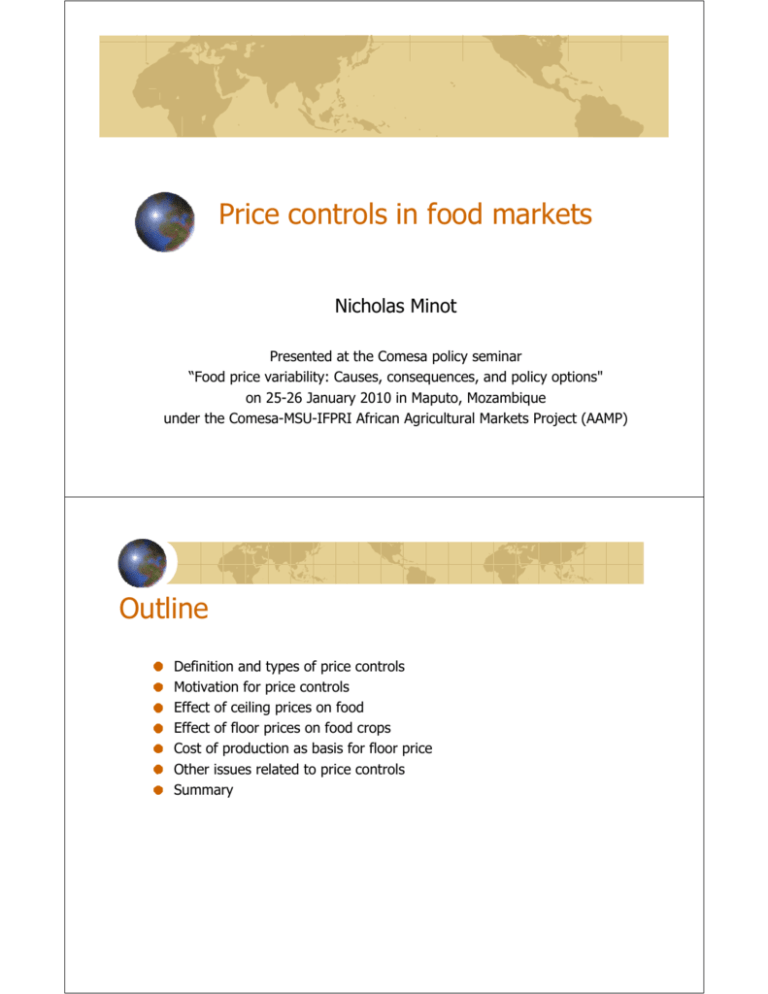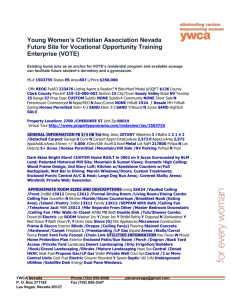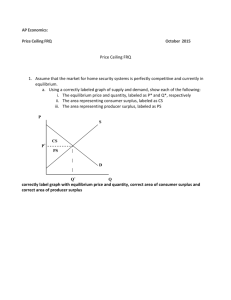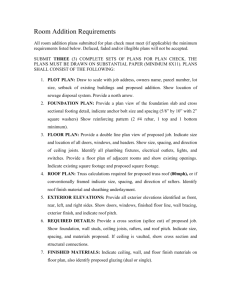Price controls in food markets Outline
advertisement

Price controls in food markets Nicholas Minot Presented at the Comesa policy seminar “Food price variability: Causes, consequences, and policy options" on 25-26 January 2010 in Maputo, Mozambique under the Comesa-MSU-IFPRI African Agricultural Markets Project (AAMP) Outline Definition and types of price controls Motivation for price controls Effect of ceiling prices on food Effect of floor prices on food crops Cost of production as basis for floor price Other issues related to price controls Summary Definition and types of price controls Definition: “Law passed by the government which dictates a price for a good or service” Types of price controls Ceiling prices (upper limit) Floor prices (lower limit) Price band (upper and lower limit) Fixed price Methods of enforcement Legal enforcement (e.g. fines) Government purchases and sales (buffer stock) Motivation for food price controls Ceiling prices (upper limit) Protect consumers from rising food prices Break “psychology” of inflation Floor prices (lower limit) Protect farmers from low prices after bumper harvest Ensure farmers a “fair” price that covers costs Price band (upper and lower limit) Reduce volatility of food prices Market price Price Demand Market price is where supply equals demand Market price depends on: Crop yield Cost of production Cost of marketing Price of competing goods Trade policy and exchange rate (if commodity is tradable) Expected changes in prices in the near future Supply Market price Quantity Ceiling price Price Suppose government decides this price is “too high” Fixes ceiling price below the market price Now food demand is greater than food supply Demand Supply Price ceiling If ceiling price can be enforced, there will be rationing of food Quantity Quantity available at the fixed price Unsatisfied demand Ceiling price Price More likely that the price cannot be enforced, in which case a black market will develop Black market price may be higher than market price Symptoms of ceiling price Commodity disappears from shops Vendors sell only to selected customers Black market appears with price above ceiling and possibly above market price Resales by consumers able to buy at official price Demand Black market price Supply Price ceiling Quantity Quantity available at the fixed price Unsatisfied demand Floor price Price Suppose government decides this price is “too low” Fixes floor price above the market price Now food supply is greater than food demand If price can be enforced, there will be a surplus i.e. unsold quantities of food Floor price Demand Supply Black market price Price ceiling Quantity Quantity demanded at floor price Excess supply Floor price Price If government buys the surplus, floor price can be maintained If government does not buy the surplus, farmers will try to sell at price that may be below the market price Symptoms of a floor price Traders reluctant to purchase, particularly in remote areas Excess supply Government may be “forced” to purchase surplus Farmers may sell at a loss on parallel market Demand Supply Price ceiling Quantity Quantity demanded at support price Excess supply Cost of production as basis for price controls Many countries use farm surveys to estimate cost of producing main crops, which are used to set support prices for crops Problems with cost of production estimates Cost of production estimates often based on recommended input levels rather than actual input levels Two largest elements of cost of crop production (land and labor) are difficult to value. Land values often affected by agricultural prices Cost of production different for each farm. Cost of production as basis for price controls Price There is no single “cost of production” Cost of production varies across farms depending on location, yield, labor costs, land costs, etc. Supply curve reflects fact that, as price rises, it becomes profitable for more farms to grow the crop “Average” cost of production too low for some, too high for others 90 80 70 60 50 40 30 20 10 0 Supply Quantity Other issues related to price controls Changes over seasons. If price remains fixed over seasons, effect will vary over year Ceiling price on food become more binding in off-season. May eliminate incentives for farmers and traders to store during harvest and release in offseason Example of maize prices in Lunzu, Malawi: If price ceiling set at US$ 170/ton, no incentive to store from May harvest to December Other issues related to price controls Changes over year If price remains fixed over several years, inflation will erode real price Ceiling price will decline in real terms, becoming even more binding over time Floor price will be eroded until no longer binding. Example of wheat in Addis Ababa: floor price of US$ 250/ton no longer binding after 2005 Other issues related to price controls Variation by location If price fixed throughout country, effect will vary by location Ceiling price will be more binding in cities and rural deficit zones. May eliminate incentives to take food to cities and remote deficit zones. Example of maize in Tanzania: If ceiling price of US$ 120/ton, no incentive to ship maize to Singida or Arusha Price of maize in June 2007 $123 $134 $119 $84 $74 $114 Summary Advantages Quick response to extreme prices Satisfies political pressure to “do something” Alleviates burden of extreme price for some households No cost to government unless it “defends” price with purchase/sales Disadvantages if no government purchase/sale Creates shortage or surplus of commodity Often leads to black market activity Benefits well-connected or lucky rather than poor Disrupts signals to motivate storage, shipments, and production Disadvantage if government purchase/sale No shortage or black market but… Often involves large costs to government Disrupts signals to motivate storage, shipments, and production








